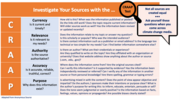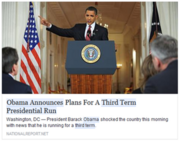BaCCC/Module 7/Lesson 2/Part 2
Media literacy
| “ | Beware of false knowledge; it is more dangerous than ignorance. | ” |
| —George Bernard Shaw | ||
The world seems to be divided today, not just into haves and have-nots, but also into those who understand and take action on the climate emergency and those who deny or ignore it. And since the climate change deniers have an amplified voice because of the Internet and social media, they have an outsized influence on decision makers and politicians who are seeking votes in the next election.
Climate change literacy comes partly through developing general media literacy. Read over the CRAAP Test (yes, that is a crude acronym . . . which makes it memorable) in the infographic below.
Now, let’s talk about fake news. In a nutshell, fake news is a problem. It intends to distort and thwart reality. It creates confusion and disorder. It is dangerous. People still fall for fake news because they do not do fact-checks.
Have a look at the articles on this webpage of the North Dakota State Library:
To dig deeper, check this webpage:
Now, go through this site to find out how to prevent fake news:
UNESCO has a webpage dedicated to media literacy infographics (scroll down for those on climate change disinformation, in a section called MIL and Climate Change):
One important tip is to never take the word of any one source. It is like gossip; if something sounds too good (or too bad) to be true, then it probably is not true. Always triangulate; that means checking at least three very different sources to try to arrive at the truth – which is usually found where their stories all intersect. For example, to triangulate the (what turned out to be fake) story above, you might check the New York Times or the Washington Post (news sources that are “on the ground”), The Guardian (a United Kingdom news source with an excellent reputation) and a national news source in your country that you trust.
You can also check the reputation and credibility of your sources at SourceWatch.org.
And did you know there are three main forms of lies, false statements, untruths or falsehoods?
1. Lying by commission – the active use of false statements to create a false impression (e.g., when an oil company says that its products are not harmful).
2. Lying by omission (telling partial truths) – the passive avoidance of the whole truth to create a false impression (e.g., when an oil company leaves out key facts and details about the impacts of its products).
3. Paltering – “using statements that are technically true, but also leave out critical information in order to mislead people” (Westerveldt, cited in Atkin, 2023).
If you want to understand the depth of dishonesty in the fossil fuel sector, try to watch The Power of Big Oil, a three-part PBS (United States) series: 1. Denial, 2. Doubt, 3. Delay. (The series is sometimes available on YouTube.)
No one can efficiently curb fake news singlehandedly. However, making your own commitment to not fall for and spread fake news will surely help a lot. Remember: Think before you share – not everything on the Internet is factual.
Let’s continue with our probing. Learning how to filter information will help you become media literate. Information is power in this digital age. Becoming media literate will empower you to produce a great deal of innovation and action to influence climate change.
|
A prerequisite for stimulating climate change engagement Media and information literacy (MIL) is an antecedent of science literacy. When MIL is combined with science literacy, they can empower ordinary citizens to contribute to the fight against climate change. The set of competencies to understand how climate change happens, its impacts, and relevant mitigation approaches are part of science literacy, often referred to as “climate literacy” [or “climate change literacy”]. They are acquired and frequently applied by means of information, media and digital technology, and are thus intertwined with MIL competencies. Citizens who lack MIL competencies are prone to climate-related disinformation and unverified claims disseminated through various forms of online and offline media. This leads to a low level of acceptance of climate change science, and ignorance of the actions that we can all take individually and collectively. The uninformed rejection of climate change science, nowadays quite common in public discourse, is a major obstacle and can be tackled with MIL. Media and technology companies play a central role in educating and informing citizens on climate change. Media outlets and information that flows on digital communications platforms can amplify the urgency of the crisis, communicate key facts about climate, and debunk climate change denial and other conspiracy theories. It is hence crucial for citizens to know how news and online content is produced, for what purposes, and based on what sources. MIL is also vital for journalists to ensure factual and evidence-based reporting on climate. Media and information literate citizens and decision makers are able to access reliable information to make informed decisions as regards consumption and carbon footprint. They are able to adapt or change their attitudes and behaviours accordingly to avoid actions or policies that can exacerbate the crisis, based on accurate information and evidence. They are equipped to proactively counter climate change and contribute to strengthening public trust of climate change science. (UNESCO, 2023) |
Under the leadership of the European Youth Information and Counselling Agency, UNESCO supported the development of the green media and information literacy concept, which calls for
1. raising awareness of the importance of checking facts related to environmental sustainability, and paying attention to information sources
2. providing people with the tools and resources needed to learn how to check sources of information, spot disinformation and spread information on the climate emergency in a responsible way
3. encouraging people to get informed on the latest news, facts and research about the climate emergency and what can be done at different levels
If you are interested in journalism as a potential career, check this resource developed by UNESCO to further your understanding of media and information literacy in journalism:
Media and Information Literacy[5]
To dig deeper, learn more and reach farther, especially if you are interested in teaching about climate change, check the following sources:
“Media Literacy as a Key Strategy Toward Improving Public Acceptance of Climate Change Science,” by Caren B. Cooper:
Media Literacy as a Key Strategy Toward Improving Public Acceptance of Climate Change Science[6]
Teaching About Climate Change Using the Tools of Media Literacy (1:08:40), by Project Look Sharp:
“Controversy in the Classroom: Strategies for Managing Climate Change Discourse,” by CLEAN:
Controversy in the Classroom: Strategies for Managing Climate Change Discourse[7]
Climate Change Literacy to Combat Climate Change and Its Impacts, by Julie Johnston:
Climate Change Literacy to Combat Climate Change and Its Impacts[8]
References
- ↑ North Dakota State Library, n.d. History of Fake News
- ↑ North Dakota State Library, n.d. Understanding Fake News
- ↑ North Dakota State Library, n.d. Preventing Fake News
- ↑ UNESCO, n.d. Visual Resources
- ↑ UNESCO, n.d. Media and Information Literacy
- ↑ Cooper, n.d. Media Literacy as a Key Strategy Toward Improving Public Acceptance of Climate Change Science
- ↑ CLEAN, n.d. Controversy in the Classroom: Strategies for Managing Climate Change Discourse
- ↑ Johnston, n.d. Climate Change Literacy to Combat Climate Change and Its Impacts



